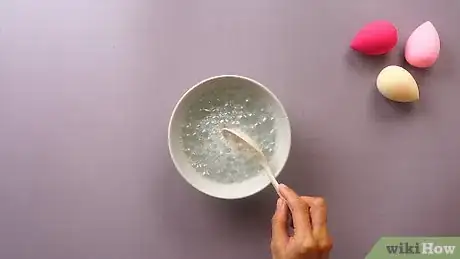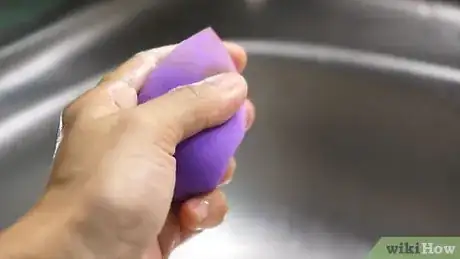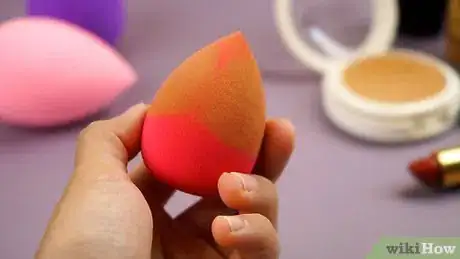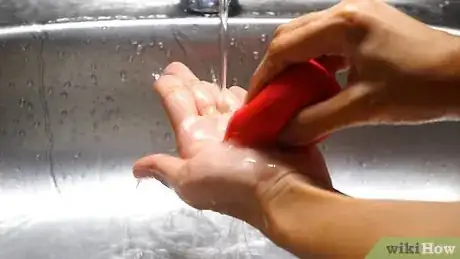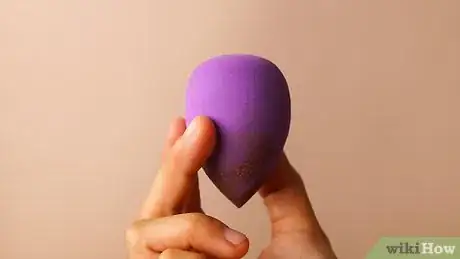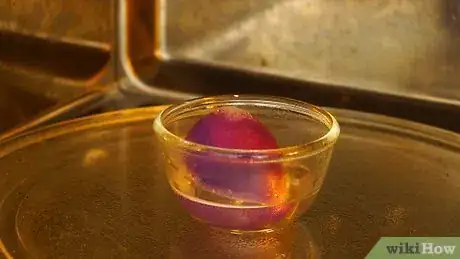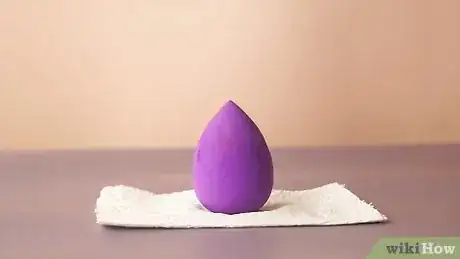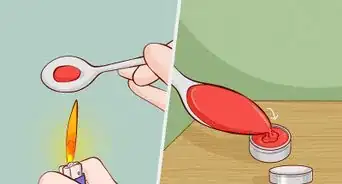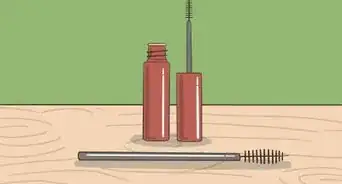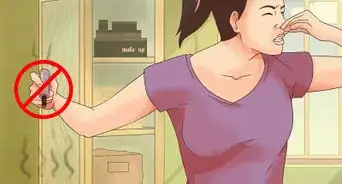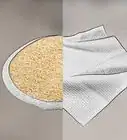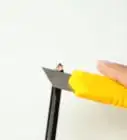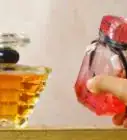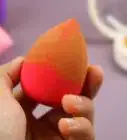This article was co-authored by Melissa Maker. Melissa Maker is host and editor of CleanMySpace, a YouTube channel and blog with over 1 million subscribers. She has over 10 years of professional cleaning experience, and dispenses helpful tips on all things home.
wikiHow marks an article as reader-approved once it receives enough positive feedback. In this case, several readers have written to tell us that this article was helpful to them, earning it our reader-approved status.
This article has been viewed 589,537 times.
Standard cosmetic sponges are disposable, but the Beauty Blender and other similar blending sponges are specially designed and meant for long-term use. As such, you'll need to regularly clean your blender sponge to remove stains and harmful bacteria.
Steps
Basic Cleansing
-
1Prepare a dish of warm, soapy water. Fill a small dish with warm water, then squeeze a dollop of gentle hand soap or shampoo into it. Mix lightly until suds form on the surface of the water. Dish soap is generally not recommended, as it can irritate your skin when you need to use the sponge later.
- Choose a soap specially formulated for makeup brushes or go with a natural body or face wash that's free of chemicals and fragrances. Avoid using face washes for acne-prone or oily skin.
- Baby shampoo and “gentle formula” organic shampoos work especially well, but most soaps that are safe for use on your skin or hair can be used here.
-
2Soak the sponge for 30 minutes. Drop the sponge into the dish of soapy water. Squeeze it two or three times with your hand, then allow it to soak for approximately 30 minutes.[1]
- The dish should have enough water in it to completely cover the blender sponge. If there isn't enough water initially, simply add more as needed.
- As the sponge soaks, the water will likely begin to change color. Expect the water to take on a dingy beige or tan hue as it draws the foundation and other cosmetics out of the sponge.
- The sponge should also expand to its full size as it soaks in the soapy water.
Advertisement -
3Massage cleanser into the sponge. Gently rub solid "Blender Cleanser" or an equivalent soap directly into the most heavily soiled areas of the sponge.You must use a gentle cleanser to avoid damaging the sponge. If you prefer solid soaps, castille soap usually works well. If you'd rather choose a liquid soap, consider moisturizing baby shampoo or an organic shampoo with a gentle formula.
- Spend 2-3 patient minutes massaging the cleanser into the sponge. Only use your fingertips; do not use a scrubbing brush or other abrasive tool since doing so could damage the sponge.
-
4Rinse the sponge free of soap. Rinse the sponge under warm, running water until all of the cleanser washes out of it. Any additional makeup sitting near the surface of the sponge should get rinsed out during this step as well.
- You may need to gently squeeze the sponge under the running water to help remove the soaps and makeup.
-
5Analyze whether or not the sponge is clean enough by the clarity of the water while rinsing. If the rinse water runs clear beneath the blender sponge, it should be adequately clean and you can move directly to the drying step. If the rinse water still seems dingy, skip the drying step and move into the deep cleaning method (see the “Deep Cleaning” section of this article).
-
6Dry using paper towels. Wring out excess water by gently squeezing the sponge with your hand, then roll the sponge in clean, dry paper towels to absorb any water still inside.
- If the sponge is still damp after you blot out the water with paper towels, let it sit in a dry location to continue air drying. Wait until the sponge is completely dry before using it as an applicator.
Deep Cleaning
-
1Deep clean the sponge only as needed. As a general rule, you'll only need to perform deep cleaning on your blender sponge if the sponge still appears dirty after following basic cleansing procedures outlined above.
- This is more likely to happen if you use your blender sponge multiple times per day or if you forget to clean it for one or more weeks.
- You'll know if your blender sponge needs deep cleaning by looking at it. If the rinse water at the end of your basic cleansing routine seems dirty, or if there are visible stains on the sponge after it dries, try deep cleaning it.
-
2Wet the sponge. Hold the sponge under warm, running water for 30 to 60 seconds, or until it absorbs enough water to expand to its full size.
- Alternatively, you could place the blender sponge in a bowl of warm water for 5 to 10 minutes. You do not need to use soapy water, nor do you need to wait for the water to change color before continuing to the next step.
-
3Apply cleanser to the soiled areas. Dab solid or liquid cleanser directly onto the most heavily soiled areas of the sponge.
- As with the basic cleaning procedure, you should only use gentle cleansers on your sponge. Specially formulated “Blender Cleanser” works well, but if you'd prefer another option, solid castille soap, liquid baby shampoo, or “sensitive formula” organic shampoos will also work.
-
4Rub the sponge against your palm. Rub the coated portions of the sponge against the center of your palm, working the sponge in small circular motions. Continue rubbing the sponge for approximately 30 seconds.[2]
- The scrubbing should be vigorous and more intense than the scrubbing used during your basic cleansing routine. Note, however, that it should still be gentle enough to avoid distorting the shape of the sponge or tearing the sponge material.
- As you scrub, the cosmetics lying deeper inside the sponge will be drawn out through the surface. You should notice the suds on your palm becoming tinted with the color of your foundation.
-
5Rinse while continuing to scrub. Rinse the sponge under warm, running water while continuing the rub it against your palm in circular movements. Keep rinsing the sponge until all of the suds are gone.
- You may need to rinse the sponge for several minutes before you clean out all the soap. It's important that you rinse out all of the soap, though, so don't rush the process.
-
6Test the sponge. Rinse the sponge under running water again until all of the suds disappear. Make sure that the water you squeeze out is clear and clean.
- Apply more cleanser to the sponge and rub it against your palm. If the resulting lather is white instead of gray or beige, the sponge should now be clean.
-
7Dry the sponge. Gently wring out most of the excess moisture by squeezing the sponge with your hand. Roll the sponge over clean, dry paper towels to dry it off even more.
- The sponge will probably still be damp after this, so set it aside in a dry place and allow it to air dry. Only use the blender sponge as an applicator once it is completely dry.
Heat Sterilization
-
1Sterilize the sponge monthly. Even if you clean your sponge on a weekly basis, you should still sterilize it using heat at least once a month. This is especially important if you use your blender sponge on a daily basis. Standard cleaning removes surface bacteria, but the only way to kill bacteria lying deeper in the sponge is by killing it with a short burst of intense heat.
- You may need to sterilize the sponge more than once a month if you notice the bacteria building up more rapidly. Signs of intense bacteria build-up include uncharacteristic acne breakouts and a foul/unusual odor coming from within the sponge.
- Note that you'll still need to perform a basic cleaning procedure after sterilizing the sponge. Sterilization will only kill the bacteria; it will not remove any cosmetic stains or foundation.
-
2Place the sponge in a dish of water. Fill a microwave-safe bowl with approximately 1 inch (2.5 cm) of water. Lay the sponge down in the center of the water puddle.
- You must sit the blender sponge in water. Do not microwave a fully dry sponge since doing so could damage the material or cause the sponge to catch fire.
-
3Microwave for 30 seconds. Place the uncovered bowl in your microwave and run the appliance at full power for 30 seconds.[3]
- Keep an eye on the blender sponge as you microwave it. Don't be alarmed if it expands slightly or if small trails of smoke develop, but stop the microwave immediately if it balloons up past its full size or if heavy smoke starts to form.
-
4Let it rest. Wait one or two minutes before removing the bowl from the microwave and removing the sponge from the water.
- The sponge will likely be very hot once the microwave cycle ends, and the waiting period is primarily for your own protection. You can actually handle the sponge as soon as it is cool enough to touch.
-
5Dry the sponge. Gently roll the sponge in clean, dry paper towels. Let it sit out at room temperature until it feels completely dry.
- If you plan on performing a basic cleansing routine on the sponge after sterilizing it with heat, you can do so immediately after pulling it out of the microwave. You do not need to dry the sponge first.
- Wait until the blender sponge is completely dry before using it as an applicator.
Community Q&A
-
QuestionWhat kind of soap can I use to wash my beauty blender?
 wikiHow Staff EditorThis answer was written by one of our trained team of researchers who validated it for accuracy and comprehensiveness.
wikiHow Staff EditorThis answer was written by one of our trained team of researchers who validated it for accuracy and comprehensiveness.
Staff Answer wikiHow Staff EditorStaff AnswerThe best soap is mild dish-washing liquid or an antibacterial liquid soap or baby shampoo. Bar soap is not suitable for cleaning a beauty blender sponge.
wikiHow Staff EditorStaff AnswerThe best soap is mild dish-washing liquid or an antibacterial liquid soap or baby shampoo. Bar soap is not suitable for cleaning a beauty blender sponge. -
QuestionCan I clean my beauty blender with olive oil?
 wikiHow Staff EditorThis answer was written by one of our trained team of researchers who validated it for accuracy and comprehensiveness.
wikiHow Staff EditorThis answer was written by one of our trained team of researchers who validated it for accuracy and comprehensiveness.
Staff Answer wikiHow Staff EditorStaff AnswerYes, you can clean your beauty blender with olive oil. To so: Use a ratio of 1:1:1 olive oil, mild liquid dish-washing soap and water to create a cleansing solution. Wash the beauty blender with this solution, then rinse clean. The antibacterial properties of olive oil are thought by some beauty experts to make this a helpful cleanser.
wikiHow Staff EditorStaff AnswerYes, you can clean your beauty blender with olive oil. To so: Use a ratio of 1:1:1 olive oil, mild liquid dish-washing soap and water to create a cleansing solution. Wash the beauty blender with this solution, then rinse clean. The antibacterial properties of olive oil are thought by some beauty experts to make this a helpful cleanser. -
QuestionCan you wash a beauty blender?
 wikiHow Staff EditorThis answer was written by one of our trained team of researchers who validated it for accuracy and comprehensiveness.
wikiHow Staff EditorThis answer was written by one of our trained team of researchers who validated it for accuracy and comprehensiveness.
Staff Answer wikiHow Staff EditorStaff AnswerA beauty blender can be washed using mild dish-washing liquid or mild shampoo. Other people use such solutions as water and baby wash or dish soap and olive oil for washing. Another trick popular with some beauty gurus for washing a beauty blender is to add it to a microwave-safe cup with lid, filled with water and some dish-washing liquid and heat for one minute; remove, let cool, then wring out the sponge.
wikiHow Staff EditorStaff AnswerA beauty blender can be washed using mild dish-washing liquid or mild shampoo. Other people use such solutions as water and baby wash or dish soap and olive oil for washing. Another trick popular with some beauty gurus for washing a beauty blender is to add it to a microwave-safe cup with lid, filled with water and some dish-washing liquid and heat for one minute; remove, let cool, then wring out the sponge.
Things You'll Need
Basic Cleansing
- Small bowl
- Water
- Gentle solid or liquid cleanser
- Sink
- Paper towels
Deep Cleaning
- Gentle solid or liquid cleanser
- Sink
- Paper towels
Heat Sterilization
- Microwave-safe bowl
- Water
- Microwave
- Paper towels
References
About This Article
To clean a beauty blender, start by filling up a bowl with warm, soapy water. Use a gentle hand soap or shampoo so you don't irritate your skin when you use your beauty blender after you clean it. Next, soak your beauty blender in the soapy water for 30 minutes. After 30 minutes, massage some more soap into it and then rinse it under warm water until there's no more soap inside. When you're finished, dry your beauty blender off with paper towels. To learn how to deep clean a beauty blender, scroll down!
